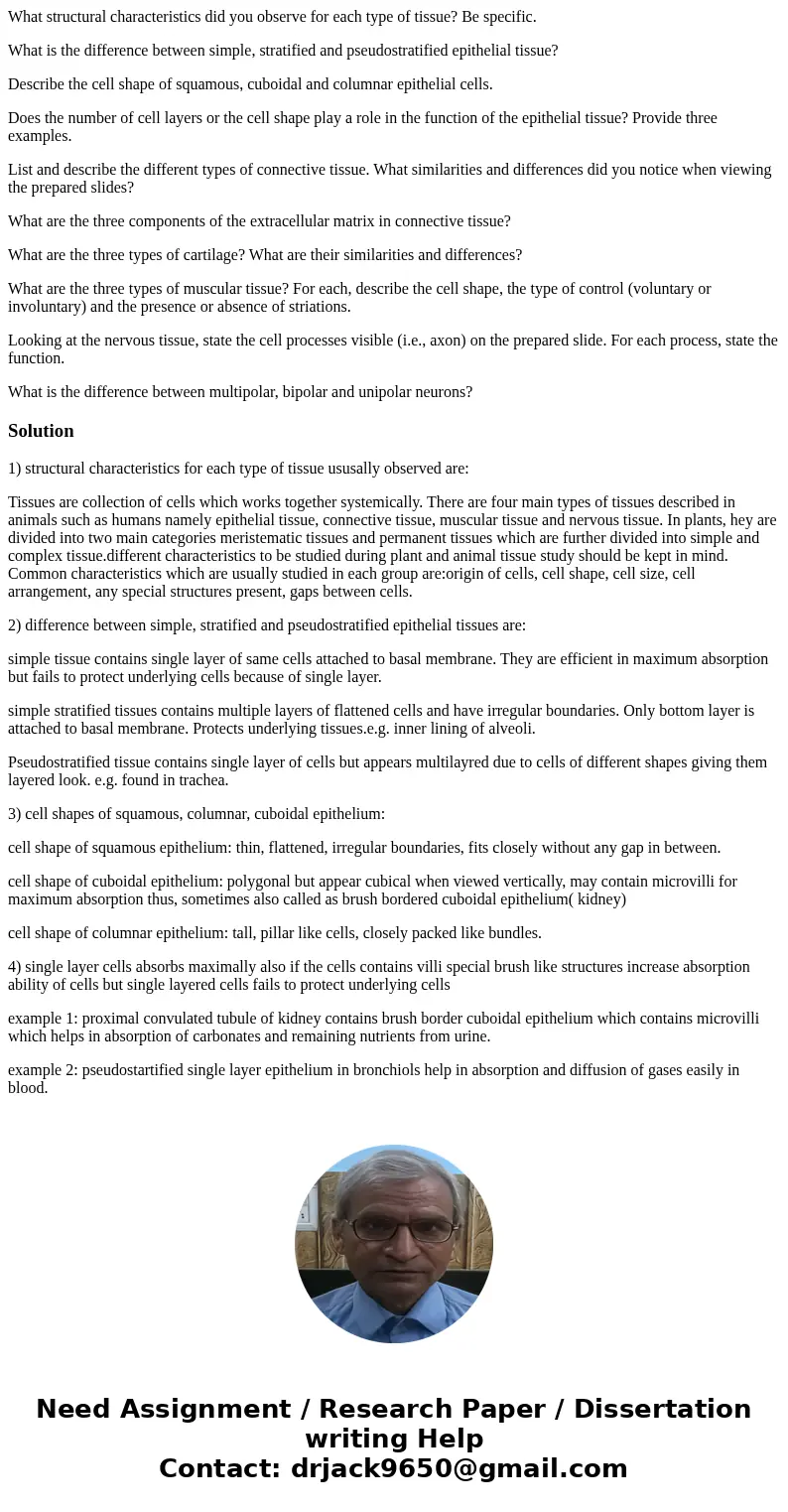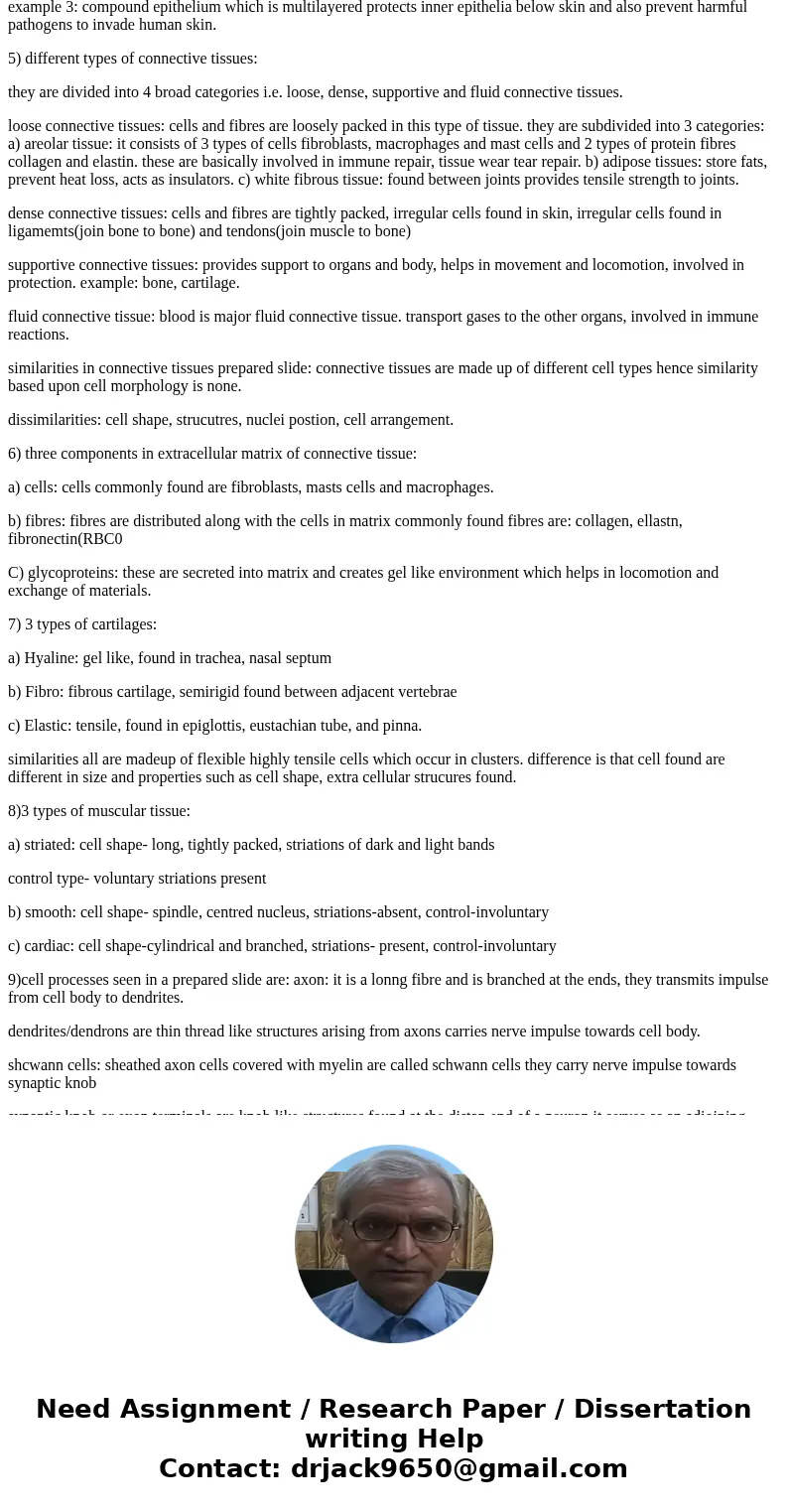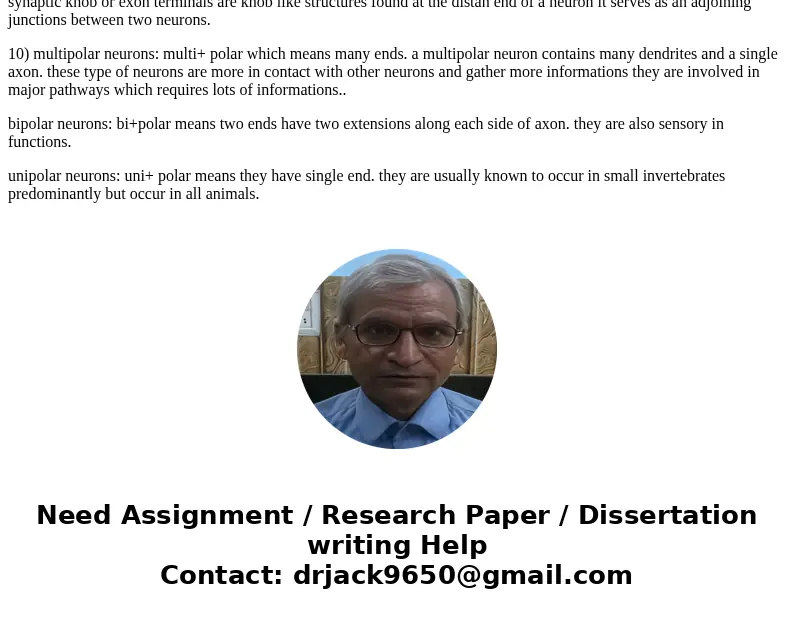What structural characteristics did you observe for each typ
What structural characteristics did you observe for each type of tissue? Be specific.
What is the difference between simple, stratified and pseudostratified epithelial tissue?
Describe the cell shape of squamous, cuboidal and columnar epithelial cells.
Does the number of cell layers or the cell shape play a role in the function of the epithelial tissue? Provide three examples.
List and describe the different types of connective tissue. What similarities and differences did you notice when viewing the prepared slides?
What are the three components of the extracellular matrix in connective tissue?
What are the three types of cartilage? What are their similarities and differences?
What are the three types of muscular tissue? For each, describe the cell shape, the type of control (voluntary or involuntary) and the presence or absence of striations.
Looking at the nervous tissue, state the cell processes visible (i.e., axon) on the prepared slide. For each process, state the function.
What is the difference between multipolar, bipolar and unipolar neurons?
Solution
1) structural characteristics for each type of tissue ususally observed are:
Tissues are collection of cells which works together systemically. There are four main types of tissues described in animals such as humans namely epithelial tissue, connective tissue, muscular tissue and nervous tissue. In plants, hey are divided into two main categories meristematic tissues and permanent tissues which are further divided into simple and complex tissue.different characteristics to be studied during plant and animal tissue study should be kept in mind. Common characteristics which are usually studied in each group are:origin of cells, cell shape, cell size, cell arrangement, any special structures present, gaps between cells.
2) difference between simple, stratified and pseudostratified epithelial tissues are:
simple tissue contains single layer of same cells attached to basal membrane. They are efficient in maximum absorption but fails to protect underlying cells because of single layer.
simple stratified tissues contains multiple layers of flattened cells and have irregular boundaries. Only bottom layer is attached to basal membrane. Protects underlying tissues.e.g. inner lining of alveoli.
Pseudostratified tissue contains single layer of cells but appears multilayred due to cells of different shapes giving them layered look. e.g. found in trachea.
3) cell shapes of squamous, columnar, cuboidal epithelium:
cell shape of squamous epithelium: thin, flattened, irregular boundaries, fits closely without any gap in between.
cell shape of cuboidal epithelium: polygonal but appear cubical when viewed vertically, may contain microvilli for maximum absorption thus, sometimes also called as brush bordered cuboidal epithelium( kidney)
cell shape of columnar epithelium: tall, pillar like cells, closely packed like bundles.
4) single layer cells absorbs maximally also if the cells contains villi special brush like structures increase absorption ability of cells but single layered cells fails to protect underlying cells
example 1: proximal convulated tubule of kidney contains brush border cuboidal epithelium which contains microvilli which helps in absorption of carbonates and remaining nutrients from urine.
example 2: pseudostartified single layer epithelium in bronchiols help in absorption and diffusion of gases easily in blood.
example 3: compound epithelium which is multilayered protects inner epithelia below skin and also prevent harmful pathogens to invade human skin.
5) different types of connective tissues:
they are divided into 4 broad categories i.e. loose, dense, supportive and fluid connective tissues.
loose connective tissues: cells and fibres are loosely packed in this type of tissue. they are subdivided into 3 categories: a) areolar tissue: it consists of 3 types of cells fibroblasts, macrophages and mast cells and 2 types of protein fibres collagen and elastin. these are basically involved in immune repair, tissue wear tear repair. b) adipose tissues: store fats, prevent heat loss, acts as insulators. c) white fibrous tissue: found between joints provides tensile strength to joints.
dense connective tissues: cells and fibres are tightly packed, irregular cells found in skin, irregular cells found in ligamemts(join bone to bone) and tendons(join muscle to bone)
supportive connective tissues: provides support to organs and body, helps in movement and locomotion, involved in protection. example: bone, cartilage.
fluid connective tissue: blood is major fluid connective tissue. transport gases to the other organs, involved in immune reactions.
similarities in connective tissues prepared slide: connective tissues are made up of different cell types hence similarity based upon cell morphology is none.
dissimilarities: cell shape, strucutres, nuclei postion, cell arrangement.
6) three components in extracellular matrix of connective tissue:
a) cells: cells commonly found are fibroblasts, masts cells and macrophages.
b) fibres: fibres are distributed along with the cells in matrix commonly found fibres are: collagen, ellastn, fibronectin(RBC0
C) glycoproteins: these are secreted into matrix and creates gel like environment which helps in locomotion and exchange of materials.
7) 3 types of cartilages:
a) Hyaline: gel like, found in trachea, nasal septum
b) Fibro: fibrous cartilage, semirigid found between adjacent vertebrae
c) Elastic: tensile, found in epiglottis, eustachian tube, and pinna.
similarities all are madeup of flexible highly tensile cells which occur in clusters. difference is that cell found are different in size and properties such as cell shape, extra cellular strucures found.
8)3 types of muscular tissue:
a) striated: cell shape- long, tightly packed, striations of dark and light bands
control type- voluntary striations present
b) smooth: cell shape- spindle, centred nucleus, striations-absent, control-involuntary
c) cardiac: cell shape-cylindrical and branched, striations- present, control-involuntary
9)cell processes seen in a prepared slide are: axon: it is a lonng fibre and is branched at the ends, they transmits impulse from cell body to dendrites.
dendrites/dendrons are thin thread like structures arising from axons carries nerve impulse towards cell body.
shcwann cells: sheathed axon cells covered with myelin are called schwann cells they carry nerve impulse towards synaptic knob
synaptic knob or exon terminals are knob like structures found at the distan end of a neuron it serves as an adjoining junctions between two neurons.
10) multipolar neurons: multi+ polar which means many ends. a multipolar neuron contains many dendrites and a single axon. these type of neurons are more in contact with other neurons and gather more informations they are involved in major pathways which requires lots of informations..
bipolar neurons: bi+polar means two ends have two extensions along each side of axon. they are also sensory in functions.
unipolar neurons: uni+ polar means they have single end. they are usually known to occur in small invertebrates predominantly but occur in all animals.



 Homework Sourse
Homework Sourse